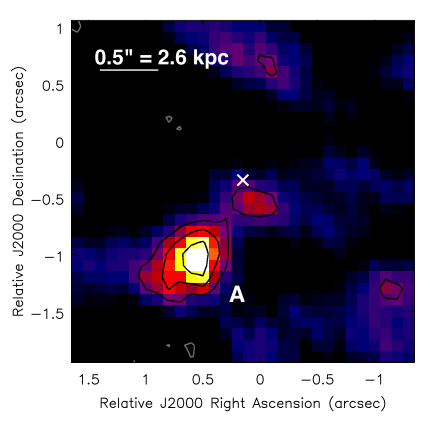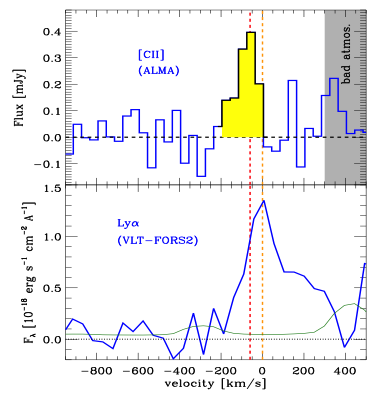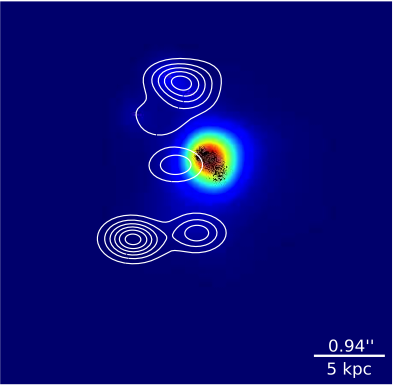ALMA detects [CII] emission from a primeval galaxy at z~7
Rebecca Williams
Roberto Maiolino is leading a study using ALMA to detect the [CII] 158μm line and continuum emission in galaxies well within the epoch of re-ionisation at z~7. These galaxies have very low star formation rates (SFRs ~10 M¤/yr) and so are more representative of the galaxy population at high redshifts than those studied in previous investigations. The [CII] 158μm line is the dominant coolant line of the ISM and so can be a powerful tool for studying the ISM in high-z galaxies. Also at z > 1, the line is redshifted into the sub-mm atmospheric window allowing it to be detected using ALMA.
By targeting the [CII] line with ALMA we have detected clumps of neutral gas in the vicinity of a galaxy at z = 7.107 which are spatially offset from the primary galaxy previously identified through Lyα + UV continuum emission (which is tracing the ionised gas). This is illustrated in Fig1 [1]. The line profile (shown in Fig2) shows that the [CII] emission is consistent with the redshift obtained from the Lyα emission (which appears artificially redshifted due to absorption of the blue shoulder from the intervening IGM indicated by the observed asymmetric line profile). The [CII] emission profile also appears much narrower than that of the Lyα, which has been previously observed [2] in an investigation of two Lyα emitters in the vicinity of BRI1202 (a QSO-SMG system). However, these observations represent ‘peculiar’ objects in an overdense environment that also hosts a quasar and hence are not representative of the bulk of the galaxy population. The recent ALMA results however are considered much more unique in the sense that it is the first time such a feature has been seen in a ‘normal’ galaxy.

Fig1. Image shows ALMA [CII] detection, which is spatially offset from the location of the primary galaxy traced by Ly alpha+UV continuum and indicated by the white cross.

Fig2. Top: Extracted ALMA spectrum showing the [CII] emission line. Bottom: Lyα spectrum showing asymmetric profile. Note that the [CII] redshift is consistent with that previously confirm through Lyα emission.
The spatial offset and spectral line differences between the [CII] emission (tracing neutral gas) and the Lyα emission (tracing ionised gas) are predicted by recent models of primeval galaxy formation. According to these models, molecular clouds in primeval galaxies are disrupted by stellar feedback whereas accreting/satellite clumps of neutral gas survive in the vicinity of the galaxy and are detectable through their [CII] emission. Fig3 shows the simulation of a primeval galaxy with a similar SFR to the observed galaxy (see Fig3 caption for details). It shows that little [CII] emission is expected at the position of the primary galaxy (shown as the colour image in Fig3) hence the majority of this [CII] emission is not expected to be as a consequence of in-situ star formation. Instead offset neutral clumps of gas emit [CII] (shown as contours in Fig3) due to irradiation from the primary ionised galaxy, which is consistent with our observation (see Fig1).

Fig 3. Simulation of a primeval galaxy at z~7.1. Colour shows the ionised gas (e.g. Lyα) tracing the primary galaxy, the black points show the UV continuum and the contours indicate the location of the neutral (i.e. [CII]) gas.
These results imply that the observations are probing galaxy formation at very early stages, which in turn will help in further constraining models of galaxy formation and identifying the key components in galaxy evolutionary scenarios.
For full details see: [1] Maiolino et al., 2015, MNRAS, submitted; [2] Williams et al. 2014, MNRAS , 439, 2096

